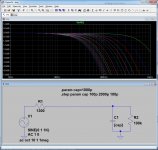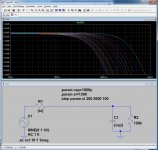Hi !
I have a question about preamps "driving ability"
I see that usually they are measured using pure resistive loads, even very low loads like 600 ohm, but never with capacitive loads
Looking at the specs of some amps I see that the input capacitance can be up to almost 1000 pF
and moreover there is a cable in between with its own capacitance
Driving inputs of this value could not effect the performance of the preamps ?
is it any power amp completely within the driving ability of any preamp ?
Thank you very much indeed for any kind advice
Kind regards,
gino
I have a question about preamps "driving ability"
I see that usually they are measured using pure resistive loads, even very low loads like 600 ohm, but never with capacitive loads
Looking at the specs of some amps I see that the input capacitance can be up to almost 1000 pF
and moreover there is a cable in between with its own capacitance
Driving inputs of this value could not effect the performance of the preamps ?
is it any power amp completely within the driving ability of any preamp ?
Thank you very much indeed for any kind advice
Kind regards,
gino
Last edited:
Interesting questions. Looking at specs for a few amps I don't see input capacitance listed except on phono stages. A quick ltspice sim does seem to show that input capacitance is at least as signifcant as source impedance which is the thing I usually concern myself with. Hopefully someone more knowledgable will chime in.
I'd like to know how to set up a test circuit to measure input capacitance of the equipment I have built.
First screen shot below is a source with 1300 ohm output impedence driving load of 100k and 100 to 2000pf.
Second screen shot is a source varying from 300 to 2000 ohm driving a load of 100k and 1000pf.
I'd like to know how to set up a test circuit to measure input capacitance of the equipment I have built.
First screen shot below is a source with 1300 ohm output impedence driving load of 100k and 100 to 2000pf.
Second screen shot is a source varying from 300 to 2000 ohm driving a load of 100k and 1000pf.
Attachments
few small signal amplifying devices in common amplifier input circuits will have more that a few 10s of pF effective input C
some amps will add a few 100s of pF to gnd as RF filter
cable can range from 10(rare, foamed dielectric)-50? pF per ft so it can be the largest C load
some feedback circuits can become unstable when loaded with C on the output - often a isolating series Z is recomended
usually this has to be > ~10 Ohms, its not too strange to see up to 100 Ohms in series with line level audio source/preamp outputs
some CD players used muting circuits that added up to kOhm series output R - less common today than earlier when noise at "digital black" level was a competive number in ads
some amps will add a few 100s of pF to gnd as RF filter
cable can range from 10(rare, foamed dielectric)-50? pF per ft so it can be the largest C load
some feedback circuits can become unstable when loaded with C on the output - often a isolating series Z is recomended
usually this has to be > ~10 Ohms, its not too strange to see up to 100 Ohms in series with line level audio source/preamp outputs
some CD players used muting circuits that added up to kOhm series output R - less common today than earlier when noise at "digital black" level was a competive number in ads
Hello !
please excuse me for another question
Could a tube line stage have problems when asked to drive a capacitive load like 500-1000 pF ?
Which could be the sonic drawbacks ?
I ask this because we made a comparison between a CJ PV10 and a Bryston preamp
The Bryston had a much stronger low end and even the top end seemed cleaner.
Thanks,
gb
please excuse me for another question
Could a tube line stage have problems when asked to drive a capacitive load like 500-1000 pF ?
Which could be the sonic drawbacks ?
I ask this because we made a comparison between a CJ PV10 and a Bryston preamp
The Bryston had a much stronger low end and even the top end seemed cleaner.
Thanks,
gb
- Status
- Not open for further replies.

